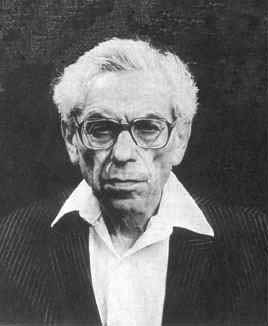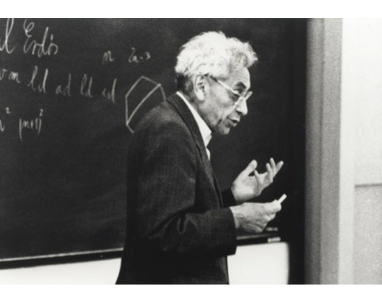The Book of the monk club
by Burkard Polster and Marty Ross
The Age, 25 March 2013

It would seem that your Maths Masters are a little eccentric. We’re not particularly concerned and we definitely don’t cultivate it, but there’s no denying the bemused reactions we frequently provoke in students and teachers. However, whatever our eccentricities, they pale in comparison to those of the astonishing and brilliant Paul Erdős.
We have already written about one monk this year, with the millennial celebration for Herman of Reichenau. Paul Erdős, who would have celebrated his 100th birthday tomorrow, was also a monk.
Not that Erdős was remotely religious. He was proud of his Jewish heritage, somewhat risky in the Hungary of his youth, but that was all. His term for God (by which he really meant fate, or the nature of things) was the Supreme Fascist. (Given Hungary’s troubled and authoritarian past (and present), it was perhaps undestandable that Erdős had a strong cynical streak.)
Paul Erdős was a mathematical monk. For over fifty years, until his death in 1996, Erdős was homeless and owned nothing beyond what would fit in a small suitcase. He simply travelled from university to university, residing at each stop with a privileged (and usually exasperated) mathematician; the mathematician would undertake the exhausting responsibility of tending to the very eccentric and needy Erdős for a few weeks, after which Erdős would move on to the next university. His story is told in a fascinating documentary (YouTube) and in an excellent biography by Paul Hoffman.
To say that Paul Erdős was prolific is a huge understatement. He worked with hundreds of mathematicians, resulting in thousands of research papers. His astonishing productivity has entered mathematical folklore in the form of the Erdős number.
A mathematician who has coauthored a paper with Paul Erdős has Erdős number 1. Or, if the mathematician has coauthored a paper with a coauthor of Erdős then they have Erdős number 2, and so on.
There are over 500 mathematicians with Erdős number 1 and almost 10,000 mathematicians with Erdős number 2. Your Maths Masters both have a rather pedestrian Erdős number of 4, slightly better than the average of around 4.6.
It is impossible to do more than hint at the vastness of Erdős’s mathematical world. A simple summary is provided by the title of Hoffman’s biography: Erdős loved numbers. In particular he loved prime numbers.
Erdős proved thousand of theorems, but he was always concerned with much more than demonstrating a given proposition. Erdős never just wanted a proof, he wanted the proof, the demonstration that explained it all. Erdős wanted the proof from The Book.
The Book, a creation of Erdős’s imagination, contains all the beautiful and elegant proofs of mathematics, all of the perfect gems. Erdős worked as if The Book were out there, as if the beautiful proofs were always there to be discovered. He claimed that mathematicians need not believe in God but that they must believe in The Book. Most do.
To give an example of a proof from The Book, consider the whole numbers from 1 to 10, and choose six of those numbers. It turns out that no matter how the numbers have been chosen, there will be two of those six numbers that have no common factor.
How can we prove that? One method is to simply list all the possible choices of six numbers and to check each possibility one by one. However, given there are 210 ways to choose the six numbers that would take a while. (And, in case you’re wondering, proofs from The Book never begin with “According to my computer …”.)
By contrast, here is the proof from The Book: since we have chosen six numbers from 1 to 10, two of those numbers must be consecutive, and consecutive numbers never share a common factor.
That’s it. One simple observation and the problem, as well as its natural generalization when choosing numbers from 1 to N, is completely understood.
Not all proofs from The Book are so short; mathematical gems tend to be complex. But many beautiful proofs do require the minimum of mathematical background.
In 1998, mathematicians Martin Aigner and Günter Ziegler published a real, physical Proofs From the Book. It was intended that Erdős be a coauthor, but instead, with Erdős’s death, the book became a tribute.
Aigner and Ziegler’s lovely book is written at the higher undergraduate level, but much is accessible to a younger audience. The very first proof is Euclid’s demonstration that there are infinitely many prime numbers, a beautiful argument that every school student should learn, just as they would learn a poem.
Another, more difficult proof in Aigner and Ziegler’s book is due to Erdős himself. Chebyshev’s Theorem, named after the great Russian mathematican Pafnuty Chbeyshev, states that between any whole number N greater than 1 and its double 2N there must be at least one prime number. For example, that must be at least one prime between 10 and 20, and indeed there are four of them: 11, 13, 17 and 19. Similarly, Chebyschev’s Theorem promises us a prime between 1,000,000 and 2,000,000, which is more difficult to confirm directly, but can readily be done with a computer at hand.
But what about verifying that there is a prime between one zillion and two zillion? Eventually, computers are of absolutely no help, conking out long before we reach infinity. Computers simply cannot provide us with a proof of Chebyshev’s Theorem, much less one from The Book.
Chebyshev proved his celebrated Theorem in 1850. However it is Erdős’s proof, discovered when he was 18, that is considered to be the proof from The Book.
There is no end to Erdős’s beautiful mathematics but his legacy goes far beyond the theorems he proved. More impressive than Erdős’s mathematics was the incredibly large number of mathematicians he inspired.
Erdős was exceedingly generous with his time, especially with younger mathematicians and school students. There is no way to accurately estimate the number of students that were thrilled and inspired by the time offered to them by the legendary Erdős, but it must be hundreds, if not thousands.
Though never married, or in a romantic relationship of any kind, Erdős loved children. He famously referred to them as epsilons (the Greek letter epsilon (ε) being commonly used in mathematics to denote a very small quantity).
It is in this light that your Maths Masters are celebrating another anniversary. Tomorrow, Paul Erdős’s100th birthday is also the very first birthday of Maths Mistress Eva.

Will Eva be a prodigy in the manner of Paul Erdős? Though she’s started early on her Platonic solids, we very much doubt it, and we’re definitely not concerned.
Erdős saw numbers as supremely beautiful. Why? “It’s like asking why Beethoven’s Ninth Symphony is beautiful. If you don’t see why, someone can’t tell you. I know numbers are beautiful. If they aren’t beautiful, nothing is.”
If Eva approaches the world with Paul Erdős’ sense of beauty and wonder, and with his concern to share it, we’ll be more than happy. Then, mathematician or not, Eva will be carrying on the spirit of this generous and beautiful man.

Burkard Polster teaches mathematics at Monash and is the university's resident mathemagician, mathematical juggler, origami expert, bubble-master, shoelace charmer, and Count von Count impersonator.
Marty Ross is a mathematical nomad. His hobby is smashing calculators with a hammer.
Copyright 2004-∞ ![]() All rights reserved.
All rights reserved.